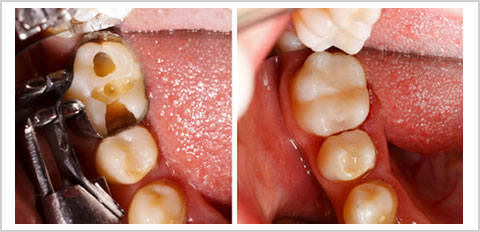Cardiff Open: Mon-Fri 9:00am-5:30pm (Sat 9am-4pm)
Singleton Open: Mon-Fri 9:00am-5:30pm (Sat Closed)
Fletcher Open: Mon-Fri 9:00am-5:30pm (Sat 9am-1pm)
Mayfield Open: Mon-Fri 9:00am-5:30pm (Sat Closed)
Cardiff : (02) 4954 7722
Singleton : (02) 6572 2526
Fletcher : (02) 4953 8614
Mayfield : (02) 4023 3885Laser Clinic
Fillings
What are White Fillings?
A White Filling is referred to as a Composite resin filling. It is a tooth coloured restoration composed of glass particles suspended in a resin matrix.
These restorations are bonded directly to the surrounding tooth structure, making them suitable for both back and front teeth. It is also available in multiple shades making it easy to match it to the colour of your natural tooth.

Why Are Dental Filling required?
Dental Composites / Fillings are used to restore worn, damaged or decayed teeth and to perform cosmetic enhancements by reshaping disfigured teeth or by changing the discoloured teeth.

How Long do Composite Fillings Last?
Recent studies have shown that composite fillings last 7-10 years except in larger fillings where crowns may be recommended by our Dentist.
It is important that you maintain good oral health hygiene for Dental Fillings to last longer.
What Types of Filling Materials are Available?
There are variety of materials used for dental fillings. Major are:
- Amalgam:
This is made up of a mixture of metals. Amalgam filling contains Mercury, Copper, Zinc, Tin and Silver. Amalgam fillings have been used for more than 150 years and is the oldest dental filling material.Amalgam fillings are the least expensive filling material and is also strong and durable. However due to its metal content, it tends to get darker with time and is clearly visible. - Composite:
Composite filling material is made up of powdered glass and acrylic resin.
Composite fillings can be made to match with the colour of your natural teeth and thus is not visible. It gives a feeling of a natural tooth. - Gold:
The most expensive filling material as anyone can imagine. At the same time, longest last filling material. - Porcelain:
Porcelain fillings look more like natural teeth.
What is the Procedure for White Fillings?
In our clinic, we use White Composite dental fillings.
First the Dentist will numb the area for pain free treatment. Then our Dentists will then drill away the decay and prepare the tooth structure for the filling.
After adequate preparation, Dentist puts the composite in layers using a special light specifically designed to strengthen each of the layers. Afterwards the dentist shapes the composite to enable it to fit the tooth. Then the dentist polishes it to prevent early wear and staining.
How Much Does a Filling Cost?
The cost of a filling depends on many factors, such as the material used, if it was a permanent filling or a temporary filling, even the size of the filling.
The average cost of a filling could range anywhere between $170 – $500 depending on the size and type of a filling.
What are the Advantages and Disadvantages of White Fillings?
Advantages-
- Aesthetics — the shade/colour of the composite fillings can be closely matched to the colour of existing teeth. Composites are particularly well suited for use in front teeth or visible parts of teeth.
- Bonding to tooth structure — composite fillings chemically bond to tooth structure, providing further support.
- Versatility — in addition to use as a filling material for decay, composite fillings can also be used to repair chipped, broken, or worn teeth.
- Tooth-sparing preparation — sometimes less tooth structure needs to be removed compared with amalgam fillings when removing decay and preparing for the filling.
Disadvantages
- Lack of durability — composite fillings wear out sooner than amalgam fillings (lasting at least five years compared with at least 10 to 15 for amalgams); in addition, they may not last as long as amalgam fillings under the pressure of chewing and particularly if used for large cavities.
- Increased chair time — because of the process to apply the composite material, these fillings can take up to 20 minutes longer than amalgam fillings to place.
- Additional visits — if composites are used for inlays or onlays, more than one office visit may be required.
- Chipping — depending on location, composite materials can chip off the tooth.
- Expense — composite fillings can cost up to twice the cost of amalgam filling
Do I Need to Replace My Old Fillings?
In the past, amalgam fillings were prized for their durability and strength to the extent that many overlook the appearance factor. With the advent of white composites, the public now finds a suitable alternative that can withstand the high stress demands that previously only gold and amalgam fillings could cope with. Since white fillings are virtually undetectable in your mouth, they also make an obvious choice for aesthetic reasons.
If you have an old amalgam filling that is overdue for replacement, why not consider the durable and aesthetically pleasing option that white fillings offer?
Deteriorating Fillings
Constant pressure from chewing, grinding, or clenching can cause dental fillings to wear away, chip, or crack. Although you may not be able to tell that a filling is wearing down, your dentist can identify weaknesses in them during a regular check-up.
If the seal between the tooth enamel and the filling breaks down, food particles and decay-causing bacteria can work their way under the filling. You then run the risk of developing additional decay in that tooth. Decay that is left untreated can progress to infect the dental pulp and may cause an abscessed tooth.

FAQs:
There are a few reasons why you may experience pain after a filling. If your filling was very deep and close to the nerve, this can sometimes calm down in a few days as the dentist would have placed a medicated lining however, there is a chance that the nerve was exposed and may now be infected, thus causing you throbbing pain after the filling. This would may require a Root Canal Treatment or an extraction.
Another reason could be a high spot on your filling. When you bite your teeth together, if the filling is even the slightest bit high in your bite, it would start to cause your tooth to ache when bitting down. This would require the dentist to slightly adjust the filling to match your bite.
Composite Fillings are fully set when you walk out of the dental clinic, however if your dentist used a local anaesthetic to numb the area it is recommended to not eat or drink until the numbness has worn off.
Temporary fillings may require you to wait.















